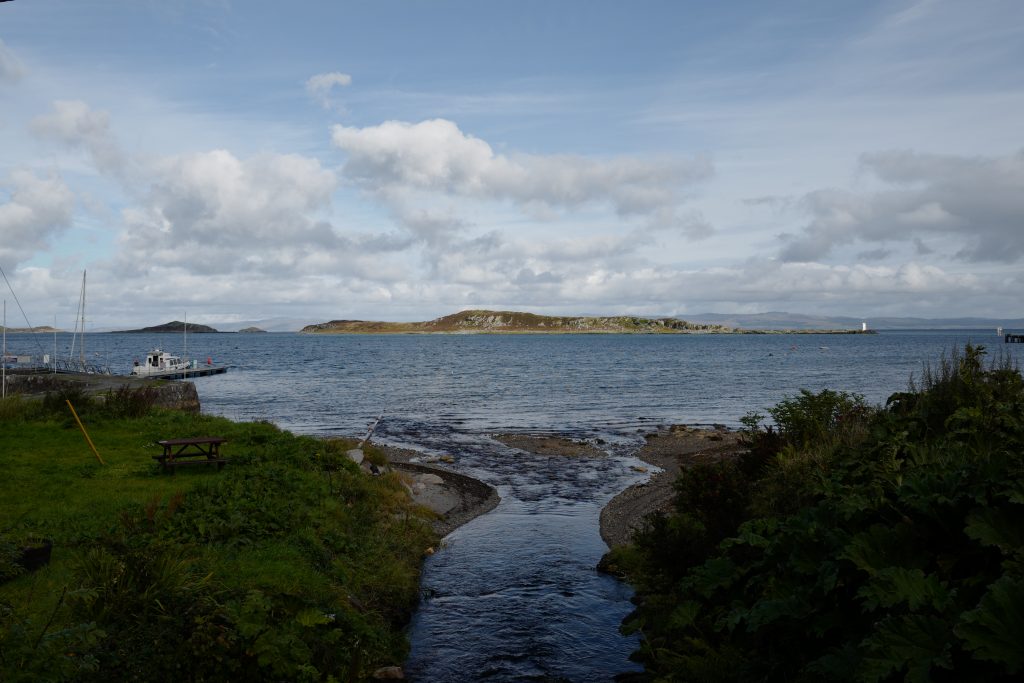September Scotch: Whisky From the Isle of Jura
“Highland Island”-style spirit from a blustery, remote Scottish island

The Isle of Jura isn’t the only Scottish island with conditions that stoke the imagination into believing one stands somewhere near the end of the earth. It does, however, carry the exclusive honor of being acknowledged by author George Orwell as the “most un-get-at-able place.” (Orwell spent much time on the island, in a very remote cottage, while working on 1984.) The frequently shifting climate and dramatic topography contribute to this reputation. As does travel reliability in non-summer months. To get to Jura, one must fly via prop-plane to Islay, its famous neighboring island, and then ferry the rest of the way. Flights can be less than reliable. Private boat charters are available, though, even in choppy waters. But, for all the tumult, there’s nothing quite so satisfying as arriving into one village in particular: Craighouse, defined by the Jura Single Malt Scotch Whisky distillery and the Jura Hotel and pub.

Roughly 212 people occupy the verdant island—with almost 5,000 red deer (and around 8,000 tourists each year) filling out the land. One single-lane road cuts up the interior coast of the island—the one angled toward Scotland. The island was gifted to the Campbell family in 1666, and that same family would build its well-known distillery come 1810. The distillery stopped production in 1901, only to resume in 1963 after ample refurbishment. Today, the distillery acts as the largest employer on Jura and produces a suite of phenomenal single malts that recently got a substantial overhaul themselves.

A few things have made—and continue to make—the whisky distinct. The distillery pulls in about 26 tons of barley from eastern Scotland every day. (This is limited by the load the ferry can take.) Their water source, Market Loch, draws from four springs and the resplendent rain. Finally, their copper stills are the second tallest in Scotland, and the tallest of any island distillery. Since the relaunch in 1963, these factors have led to predominantly lighter and sweeter whiskies—a noticeable departure from what one associates with spirits from Scottish islands.

Rachel Jones, Jura Distillery Visitor Centre Manager (a role that has required her to build an expertise in the brand’s history) shares with us, “In the very old days, we produced a peated spirit. In the ’60s we went unpeated for a while—trying to be different from our neighbors.” For decades they produced a core range that focused on sweet whisky without smoke—they offering some core products with peat and occasionally offering limited edition peated products. Despite the renowned quality of the whisky, people wanted a uniform message coming from the distillery.

“We went back to our roots,” Graham Long, the Distillery Manager, tells us. “We went back to the 1800s again and peated whisky. But because we produce about 9% of our range a year as peated, we added that 9% peated whisky production to everything—and married it in.” The new range was introduced last year, beginning with a 10-year-old introductory product. It’s rich and acceptably sweet—with smokey undertones that simply act as punctuation. It’s a superb introduction to single malts, and something those with more knowledge of the category can covet. From there, a Seven Wood packs more of a punch and a well-priced 18-year-old delivers a full-bodied blitz.

“It’s the pulling together of Highland and Island styles,” Jones continues. “We’ve always been a Highland-style, because we’ve got tall stills which producer lighter, sweeter liquid. But we are an island, and even though there are lots of islands around Scotland that produce whisky, the Scotch world is dominated by the idea that Islay is peat, so people say island and think peat, too. But we are one-of-a-kind, a Highland-Island style. It is a cohesive range of lightly smokey, sweet signature style.”

If one hasn’t tried the tipple, it’s still likely they’ve seen the distinct bottle. “The original bottle shape had shoulders and hips, too,” Jones continues, “The story goes that when they were transporting bottles from Jura to elsewhere, this shape meant that there was less chance of breakage. Over the years, people noted that it had a similar nipped-in waist like the stills.” Personally, she notes that there’s an ergonomic benefit. “It’s also just a nice bottle to hold. And, for us, it’s a shape that’s our own.” Over the years the bottle has evolved, but always maintained the same general shape.

Both Jones and Logan are transplants to the island. The island is not just the whisky and the whisky is not just the island. As Claire Clark, the brand’s Senior Communications Manager, says it’s an island of “bogs, burns, heather and heath.” There’s also an undeniable charm, bolstered by the challenges of arriving.

“When I first arrived here, I was in the navy,” Logan says. “My mom and dad had moved here. I visited Jura and came down to the pub. It was a really strange sensation. It was coming home. People were nosy—questioning me about everything, but that night I got invited to a party, and then a dinner and I met my future-wife that same night. I had never been to anywhere in Scotland like it.” Any experience in the pub today emulates Logan’s words.
Jones was drawn back time and again. “Jura lets me be the best version of myself,” she adds. “It’s here. You’re committed, open and you help your neighbors.” This nods back to the distillery. It was reopened in ’63 to combat the island’s economic depression and to stop the people from leaving. It was an investment back into the land and its people. As a result, there’s an award-winning single malt making its way around the world today—from its one small port.
Images by David Graver












